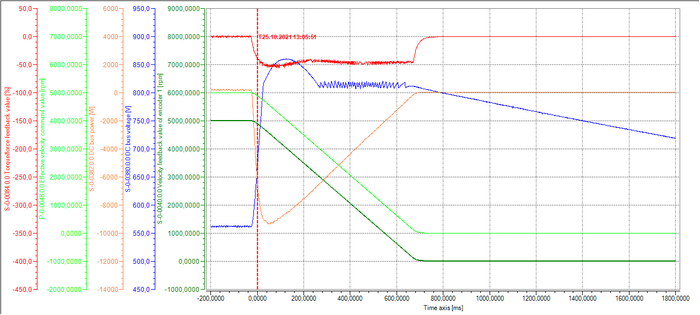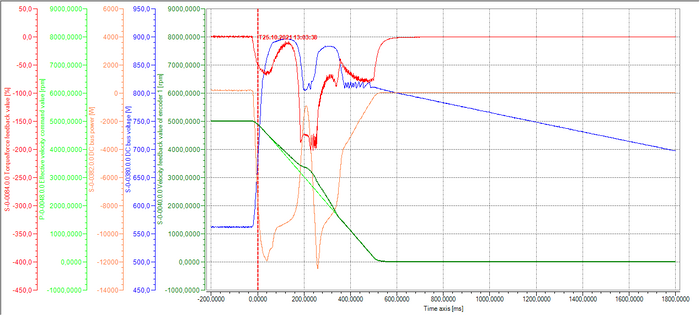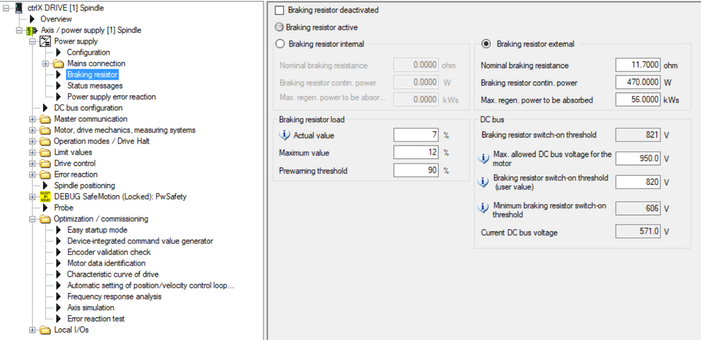- Subscribe to RSS Feed
- Mark as New
- Mark as Read
- Bookmark
- Subscribe
- Printer Friendly Page
- Report Inappropriate Content
Check of maximum bleeder capabilities
First one needs to think about the worst case scenario where most maximum energy needs to be absorbed by the drive system, if coping in decelerating from high speed and/or in lowering masses/weights over a long stroke.
The bleeder capabilities are determined in choosing the right bleeder resistors for the drive system. As example see in here the technical data of an external bleeder resistor wired to a XCS2-W0100.
Fig. 0: External bleeder resistor data
After studying this particular drive system the most energy needs to be absorbed if decelerating from high speed.
If decelerating from 5000 rpm using 750 rad/s2 everything seems fine.
Fig. 1: Decelerating from 5000 rpm using a deceleration of 750 rad/s2
The blue curve, which is the DC bus voltage, after deceleration is started, increases rapidly from around 560 V to 820 V, which is the bleeder threshold voltage. The bleeder resistor is being switched on and converts the kinetic energy in heat dissipated by the resistor. But as the maximum bleeder power capability of the resistor is exceeded (Pmax = U2 / R = 8202 (V2)/ 100 (Ohm) = 6724 W)(compare as well to the orange curve showing the DC bus power) the DC bus voltage rises to 850 V. At higher DC bus voltage the bleeder power capabilities increase and thus the DC bus voltage is being reduced again as enough energy can be absorbed. The voltage, as the decelerating goes on, stays at around 820 V, which is the bleeder threshold voltage. Here the bleeder resistor is switched off and on all the time to absorb the kinetic energy. After coming to standstill the bleeder is switched off and the DC bus voltage is slowly decreasing caused by losses in the system.
BUT: If decelerating from 5000 rpm using 1000 rad/s2 things look weird.
Fig. 2: Decelerating from 5000 rpm using a deceleration of 1000 rad/s2
The blue curve, which is the DC bus voltage, after deceleration is started, increases rapidly from around 560 V to 820 V, which is the bleeder threshold voltage. The bleeder resistor is being switched on and converts the kinetic energy in heat dissipated by the resistor. But as the maximum bleeder power capability of the resistor is exceeded (Pmax = U2 / R = 8202 (V2)/ 100 (Ohm) = 6724 W)(compare as well to the orange curve showing the DC bus power) the DC bus voltage rises to 900 V which is the maximum voltage allowed in the system. To prevent damage to the drive system the regulation inside the drive is switched off, thus the motor speed is idling. The motor doesn´t follow the speed command any longer. In doing so the DC bus voltage is lowering to 820 V - the bleeder threshold voltage - which allows the bleeder resistor to being switched on again and converting the kinetic energy in heat dissipated by the resistor. But as the maximum bleeder power capability of the resistor is still exceeded (Pmax = U2 / R = 8202 (V2)/ 100 (Ohm) = 6724 W) the DC bus voltage rises again to 850 V. At higher DC bus voltage the bleeder power capabilities increase and thus the DC bus voltage is being reduced again as enough energy can be absorbed. The voltage, as the decelerating goes on, stays at around 820 V, which is the bleeder threshold voltage. Here the bleeder resistor is switched off and on all the time to absorb the kinetic energy. After coming to standstill the bleeder is switched off and the DC bus voltage is slowly decreasing caused by losses in the system.
Similarly, if decelerating from 6000 rpm using 750 rad/s2, things look weird as well.
Fig. 3: Decelerating from 6000 rpm using a deceleration of 750 rad/s2
The explanation what is going on follows the in before statements made.
Conclusion is, that with the bleeder resistor chosen, the motor can be decelerated with 750 rad/s2 from 5000 rpm in the utmost. To improve the behavior another bleeder resistor has to be selected.
After that the following bleeder resistor was selected.
Fig. 4: Changed external bleeder resistor data (continuous power even slightly smaller, but bleeder resistance much smaller if compared to former bleeder resistor)
If now decelerating from 6000 rpm using 1000 rad/s2 everything is fine.
Fig. 5: Decelerating from 6000 rpm using a deceleration of 1000 rad/s2
The blue curve, which is the DC bus voltage, after deceleration is started, increases rapidly from around 560 V to 820 V, which is the bleeder threshold voltage. The bleeder resistor is being switched on and converts the kinetic energy in heat dissipated by the resistor. Now, as the maximum bleeder power capability of the resistor is well sized (Pmax = U2 / R = 8202 (V2)/ 11,7 (Ohm) = 57470 W)(compare as well to the orange curve showing the DC bus power) the DC bus voltage keeps at 820 V - the bleeder threshold voltage. Here the bleeder resistor is switched off and on all the time to absorb the kinetic energy. After coming to standstill the bleeder is switched off and the DC bus voltage is slowly decreasing caused by losses in the system.
This is how the behavior should be.
Similarly the behavior should be checked in mains cut off situation at systems using regenerating power supply units XVR.
Check of continuous bleeder capabilities
Second one needs to think about the worst case scenario where most continuous energy needs to be absorbed by the drive system, if coping in decelerating from high speed and/or in lowering masses/weights over a long stroke.
Please monitor the thermal load of the braking (bleeder) resistor (parameter P-0-0844)!
Fig. 6: Typical cycle over longer time --> thermal load of braking (bleeder) resistor not stable but still increasing
In here the thermal load is sill increasing thus not in the final stable condition. But it is far away from reaching more than 90%. Therefor wait for some time and repeat the measurement.
Fig. 7: Typical cycle over longer time --> thermal load of braking (bleeder) resistor now stable, means no longer increasing
In here the thermal load is no longer increasing thus in a final stable condition. With around 58% thermal load the bleeder resistor is well chosen.
Similarly another application or cycle was checked.
Fig. 8: Typical cycle over longer time --> thermal load of braking (bleeder) resistor not stable but still increasing
In here the thermal load is sill increasing thus not in the final stable condition. Additionally it has reached a value of more than 95%. Therefor the bleeder resistor would have been chosen not properly .
You must be a registered user to add a comment. If you've already registered, sign in. Otherwise, register and sign in.












